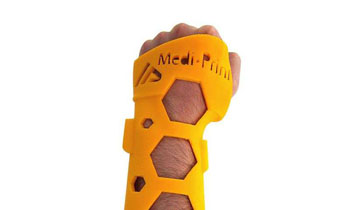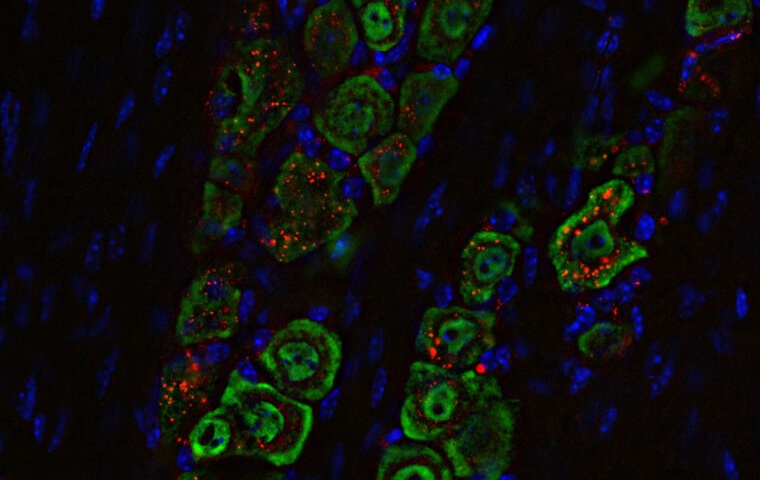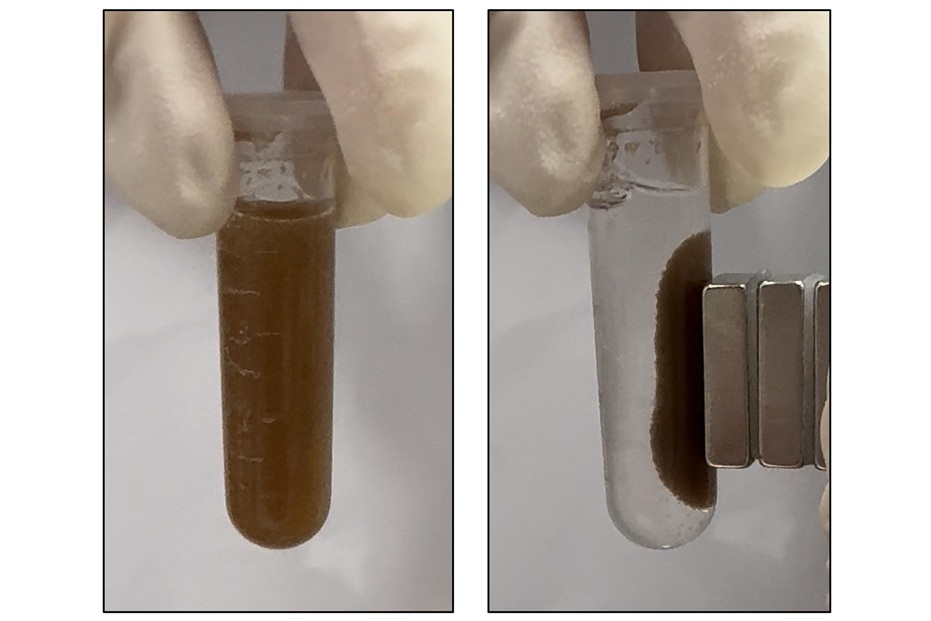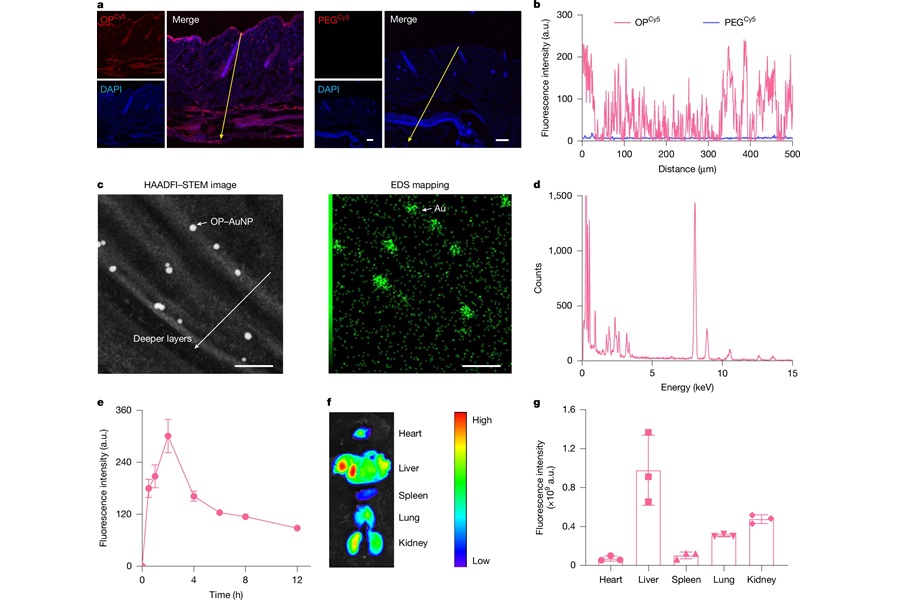3D Printed Cast Replaces Traditional Plaster
|
By HospiMedica International staff writers Posted on 27 Apr 2016 |

Image: The NovaCast 3D printed cast (Photo courtesy of Medi-Print).
A novel three-dimensional (3D) printed customizable alternative for splint casts provides good ventilation, can be washed, and is up to ten times lighter than plaster.
Developed by graduates of the National University of Mexico (UNAM, Mexico City), the NovaCast does not require prior optical or computerized tomography (CT) scan data to generate the cast, but is instead designed using a software algorithm that defines the ideal spatial geometry and the precise measurements needed for fabrication, based on individual parameters entered by the physician. The resulting cast can be printed using a polymer in an average of three and a half hours, depending on the size of the person.
The resulting cast weighs a tenth of the weight of a similar plaster cast, is easily removable, aesthetically pleasing, and hygienic, and can be personalized per demand; it even allows the wearer to bathe with it. The UNAM graduates patented the technology and formed a startup called Medi-Print (Mexico City, Mexico), to manufacture the 3D printers. The company is currently doing research in order to reduce target time to just one hour, and plans to take the technology to hospitals and increase the number of 3D printers.
“The material with which conventional splints are made is plaster, which is highly hygroscopic; this means that it absorbs sweat and causes the bacteria to proliferate because there almost no ventilation,” said mechatronic engineer Zaid Musa Badwan, founder of Medi-Print. “In worst case scenarios, you can lose a limb because of the complications caused by ulcers. Sometimes bones do not properly heal due to badly placed casts either.”
Traditional casts are a shell--frequently made from plaster or fiberglass--that encase a limb or other parts of the body to stabilize and hold anatomical structures, most often broken bones, in place until healing is confirmed. Advantages of plaster casts include accurate molding for a snug and comfortable fit; in addition, plaster is smooth and does not snag clothing or abrade the skin. The major disadvantages are that due to the nature of the dressing, the limb is unreachable during treatment; the skin becomes dry and scaly; and cutaneous complications abound. In hot weather, staphylococcal infection of the hair follicles and sweat glands can lead to severe and painful dermatitis.
Related Links:
National University of Mexico
Medi-Print
Developed by graduates of the National University of Mexico (UNAM, Mexico City), the NovaCast does not require prior optical or computerized tomography (CT) scan data to generate the cast, but is instead designed using a software algorithm that defines the ideal spatial geometry and the precise measurements needed for fabrication, based on individual parameters entered by the physician. The resulting cast can be printed using a polymer in an average of three and a half hours, depending on the size of the person.
The resulting cast weighs a tenth of the weight of a similar plaster cast, is easily removable, aesthetically pleasing, and hygienic, and can be personalized per demand; it even allows the wearer to bathe with it. The UNAM graduates patented the technology and formed a startup called Medi-Print (Mexico City, Mexico), to manufacture the 3D printers. The company is currently doing research in order to reduce target time to just one hour, and plans to take the technology to hospitals and increase the number of 3D printers.
“The material with which conventional splints are made is plaster, which is highly hygroscopic; this means that it absorbs sweat and causes the bacteria to proliferate because there almost no ventilation,” said mechatronic engineer Zaid Musa Badwan, founder of Medi-Print. “In worst case scenarios, you can lose a limb because of the complications caused by ulcers. Sometimes bones do not properly heal due to badly placed casts either.”
Traditional casts are a shell--frequently made from plaster or fiberglass--that encase a limb or other parts of the body to stabilize and hold anatomical structures, most often broken bones, in place until healing is confirmed. Advantages of plaster casts include accurate molding for a snug and comfortable fit; in addition, plaster is smooth and does not snag clothing or abrade the skin. The major disadvantages are that due to the nature of the dressing, the limb is unreachable during treatment; the skin becomes dry and scaly; and cutaneous complications abound. In hot weather, staphylococcal infection of the hair follicles and sweat glands can lead to severe and painful dermatitis.
Related Links:
National University of Mexico
Medi-Print
Latest Surgical Techniques News
- Novel Endoscopy Technique Provides Access to Deep Lung Tumors
- New Study Findings Could Halve Number of Stent Procedures
- Breakthrough Surgical Device Redefines Hip Arthroscopy
- Automated System Enables Real-Time "Molecular Pathology" During Cancer Surgery
- Groundbreaking Procedure Combines New Treatments for Liver Tumors
- Ablation Reduces Stroke Risk Associated with Atrial Fibrillation
- Optical Tracking Method Identifies Target Areas in Robot-Assisted Neurosurgery
- General Anesthesia Improves Post-Surgery Outcomes for Acute Stroke Patients
- Drug-Coated Balloons Can Replace Stents Even in Larger Coronary Arteries
- Magnetic Kidney Stone Retrieval Device Outperforms Ureteroscopic Laser Lithotripsy
- Absorbable Skull Device Could Replace Traditional Metal Implants Used After Brain Surgery
- Magic Silicone Liquid Powered Robots Perform MIS in Narrow Cavities
- 'Lab-on-a-Scalpel' Provides Real-Time Surgical Insights for POC Diagnostics in OR
- Biodegradable Brain Implant Prevents Glioblastoma Recurrence
- Tiny 3D Printer Reconstructs Tissues During Vocal Cord Surgery
- Minimally Invasive Procedure for Aortic Valve Disease Has Similar Outcomes as Surgery
Channels
Critical Care
view channel
Nasal Drops Fight Brain Tumors Noninvasively
Glioblastoma is one of the most aggressive and fatal brain cancers, progressing rapidly and leaving patients with very limited treatment options. A major challenge has been delivering effective therapies... Read more
AI Helps Optimize Therapy Selection and Dosing for Septic Shock
Septic shock is a life-threatening complication of sepsis and remains a leading cause of hospital deaths worldwide. Patients experience dangerously low blood pressure that can rapidly lead to organ failure,... Read more
Glowing Bacteria ‘Pills’ for Detecting Gut Diseases Could Eliminate Colonoscopies
Diagnosing gastrointestinal diseases such as colitis and colorectal cancer often relies on colonoscopy, an invasive procedure that many patients avoid despite ongoing symptoms like bleeding, cramping, and diarrhoea.... Read morePatient Care
view channel
Revolutionary Automatic IV-Line Flushing Device to Enhance Infusion Care
More than 80% of in-hospital patients receive intravenous (IV) therapy. Every dose of IV medicine delivered in a small volume (<250 mL) infusion bag should be followed by subsequent flushing to ensure... Read more
VR Training Tool Combats Contamination of Portable Medical Equipment
Healthcare-associated infections (HAIs) impact one in every 31 patients, cause nearly 100,000 deaths each year, and cost USD 28.4 billion in direct medical expenses. Notably, up to 75% of these infections... Read more
Portable Biosensor Platform to Reduce Hospital-Acquired Infections
Approximately 4 million patients in the European Union acquire healthcare-associated infections (HAIs) or nosocomial infections each year, with around 37,000 deaths directly resulting from these infections,... Read moreFirst-Of-Its-Kind Portable Germicidal Light Technology Disinfects High-Touch Clinical Surfaces in Seconds
Reducing healthcare-acquired infections (HAIs) remains a pressing issue within global healthcare systems. In the United States alone, 1.7 million patients contract HAIs annually, leading to approximately... Read moreHealth IT
view channel
EMR-Based Tool Predicts Graft Failure After Kidney Transplant
Kidney transplantation offers patients with end-stage kidney disease longer survival and better quality of life than dialysis, yet graft failure remains a major challenge. Although a successful transplant... Read more
Printable Molecule-Selective Nanoparticles Enable Mass Production of Wearable Biosensors
The future of medicine is likely to focus on the personalization of healthcare—understanding exactly what an individual requires and delivering the appropriate combination of nutrients, metabolites, and... Read moreBusiness
view channel
Philips and Masimo Partner to Advance Patient Monitoring Measurement Technologies
Royal Philips (Amsterdam, Netherlands) and Masimo (Irvine, California, USA) have renewed their multi-year strategic collaboration, combining Philips’ expertise in patient monitoring with Masimo’s noninvasive... Read more
B. Braun Acquires Digital Microsurgery Company True Digital Surgery
The high-end microsurgery market in neurosurgery, spine, and ENT is undergoing a significant transformation. Traditional analog microscopes are giving way to digital exoscopes, which provide improved visualization,... Read more
CMEF 2025 to Promote Holistic and High-Quality Development of Medical and Health Industry
The 92nd China International Medical Equipment Fair (CMEF 2025) Autumn Exhibition is scheduled to be held from September 26 to 29 at the China Import and Export Fair Complex (Canton Fair Complex) in Guangzhou.... Read more














